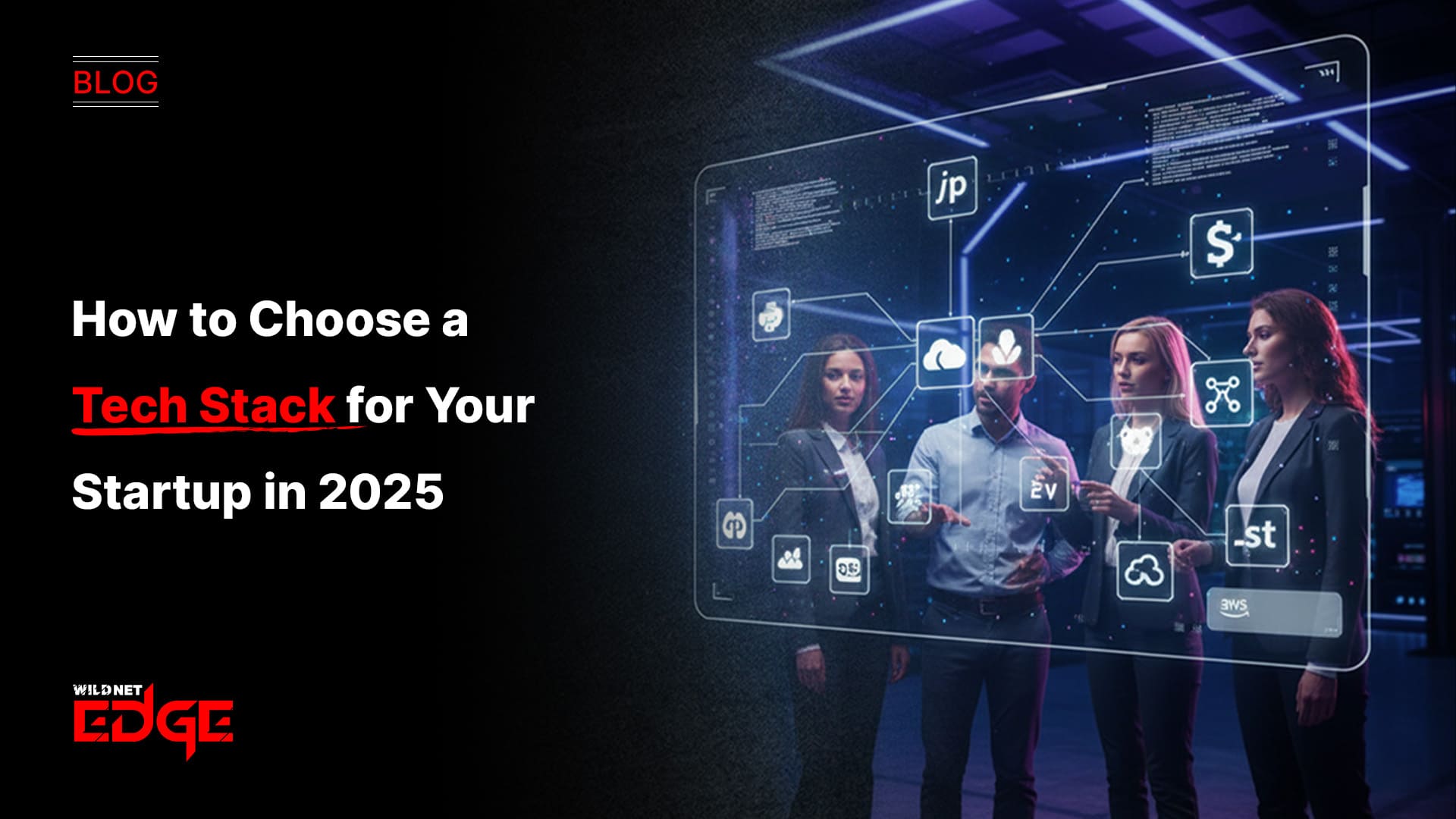TL;DR
This article serves as a guide for founders on selecting the optimal tech stack for startup ventures. It explains that the technology choices made early on significantly impact development speed, cost, scalability, and the ability to attract talent. The blog explains key factors to consider, such as project requirements, performance needs, team expertise, and long-term scalability. It discusses standard components like frontend frameworks, backend languages, databases, and cloud infrastructure. Emphasizing that there’s no single “best” stack, the article advises aligning technology choices with specific business goals and planning for a scalable architecture for startups from the outset.
For a startup founder, the early decisions are often the most critical. Among the most impactful of these is choosing the right technology stack. The tech stack for startup success is not just a collection of programming languages and tools; it’s the fundamental building block upon which your entire product and business will be built. Making the right choices early on can accelerate your growth, while the wrong ones can lead to costly technical debt and significant roadblocks down the line.
What is a Tech Stack?
A tech stack is the combination of programming languages, frameworks, libraries, databases, and other software tools used to build and run a web or mobile application. It typically consists of several layers:
- Frontend (Client-Side): What the user sees and interacts with, e.g., React, Angular, Vue.js, Swift, Kotlin.
- Backend (Server-Side): The “engine” that handles business logic, data processing, and communication with the database (e.g., Node.js, Python, Ruby on Rails, Java, NET).
- Database: Where your application’s data is stored (e.g., PostgreSQL, MySQL, MongoDB).
- Infrastructure: The servers, cloud services, and operating systems that host your application (e.g., AWS, Google Cloud, Azure, Docker, Kubernetes).
Choosing the right tech stack for a startup involves selecting the best combination of these components for your specific needs.
Why Your Tech Stack Choice Matters So Much
This decision impacts nearly every aspect of your startup’s trajectory.
- Speed of Development: Some stacks allow for faster prototyping and iteration, crucial for getting an MVP to market quickly.
- Scalability: Will your stack handle growth? Choosing a scalable architecture for startups from the beginning prevents costly re-platforming later.
- Performance: The stack directly influences your application’s speed and responsiveness, which impacts user experience and SEO.
- Cost: Development costs, hosting fees, and licensing can vary significantly between different technologies.
- Talent Pool: Choosing a popular, modern tech stack in 2025 makes it easier and often cheaper to hire skilled developers.
Key Factors to Consider When Choosing Your Stack
There is no single “best tech stack for startups.” The optimal choice depends entirely on your unique circumstances. Consider these factors:
1. Project Requirements and Complexity
Ask the most important question: What does your application actually need to do? A simple content website has different requirements than a real-time financial trading platform or a complex AI-powered application. Match the complexity of the stack to the complexity of the problem.
2. Scalability Needs
How much growth do you anticipate? If you expect rapid user adoption or large data volumes, you need to prioritize technologies known for their ability to scale horizontally. Planning for a scalable architecture for startups is non-negotiable for this, and it often influences decisions around databases and backend languages.
3. Your Team’s Expertise
What skills does your current team (or the team you plan to hire) have? While learning new technologies is possible, exploiting existing expertise can significantly accelerate your initial development speed. However, don’t let current skills dictate a choice that isn’t right for the long term.
4. Time-to-Market Constraints
How quickly do you need to launch an MVP? Frameworks with rich ecosystems, pre-built components, and rapid development features (like Ruby on Rails or Node.js with Express) can be advantageous when speed is the absolute top priority. This is a common consideration in SaaS Development.
5. Security Requirements
Does your application handle sensitive data (e.g., financial, healthcare)? Some languages and frameworks have stronger security track records or more robust built-in security features than others. Security must be a primary consideration, especially for Enterprise App Development.
Popular Choices in the Modern Tech Stack 2025
While the landscape is constantly evolving, some common and powerful combinations include:
- MERN/MEAN: (MongoDB, Express.js, React/Angular, Node.js) – Popular for fast development, especially for web apps. Uses JavaScript throughout.
- Python/Django/PostgreSQL: Robust, scalable, and excellent for data-intensive applications and AI/ML features.
- Ruby on Rails/PostgreSQL: Known for extremely rapid development and a strong convention-over-configuration philosophy, great for MVPs.
- LAMP: (Linux, Apache, MySQL, PHP) – A classic, stable, and widely supported stack, particularly strong for content management systems like WordPress.
Case Studies
Case Study 1: A Fast-Moving Social App MVP
- The Challenge: A startup needed to launch a social networking MVP on both iOS and Android within four months to test user engagement. Speed and cross-platform reach were at their peak.
- Our Solution: We recommended and implemented a tech stack for startup success using Flutter for the cross-platform mobile app and Firebase for the backend. This combination allowed for incredibly rapid UI development (“Hot Reload”) and eliminated the need for complex backend infrastructure management in the early stages.
- The Result: The MVP was launched on both app stores in under 3.5 months. The speed allowed the founders to quickly gather user feedback and iterate, while the cost savings from the cross-platform approach preserved their limited seed funding.
Case Study 2: A Scalable B2B SaaS Platform
- The Challenge: A B2B SaaS startup knew their platform needed to handle large enterprise clients and significant data volumes from day one. Scalability and reliability were top priorities.
- Our Solution: We designed a scalable architecture for startups using Python (Django) for the backend API, React for the frontend, PostgreSQL for the relational database, and deployed it on AWS using Docker and Kubernetes for automated scaling.
- The Result: The platform launched with a robust and highly scalable foundation. As they onboarded larger clients, the infrastructure scaled seamlessly, maintaining high performance and reliability, which became a key competitive advantage. This required deep expertise in Custom Software Development.
Our Technology Stack Expertise
We have deep experience across a wide range of modern technologies.
- Frontend: React, Angular, Vue.js, Flutter, Swift, Kotlin
- Backend: Node.js, Python, .NET, Java, Ruby on Rails, Go
- Databases: PostgreSQL, MySQL, MongoDB, SQL Server, Redis
- Cloud Platforms: AWS, Azure, Google Cloud
- DevOps: Docker, Kubernetes, Terraform, Jenkins
Conclusion
Choosing the right tech stack for startup success is a blend of technical understanding and strategic foresight. There is no magic bullet; the “best” stack is the one that best aligns with your specific product requirements, business goals, and long-term vision. Prioritize scalability, consider your team’s skills, and focus on technologies that enable rapid iteration during the crucial early stages.
Ready to build a product on a solid technical foundation? At Wildnet Edge, our AI-first approach ensures we create intelligent, future-proof Software Development Solutions. We don’t just write code; we partner with you to make the strategic technology choices that will drive your startup’s success, whether it’s ERP Software Development or another complex build.
FAQs
It has a significant impact. Choosing a popular and widely used modern tech stack 2025 like those based on JavaScript, Python, or Java generally makes it easier and faster to find skilled developers compared to using more niche or older technologies.
It’s a trade-off. While speed is critical for an MVP, choosing a stack with absolutely no path to scalability can lead to a costly rewrite later. Aim for a stack that is fast enough for the MVP but is built on principles that allow for future scaling.
Not necessarily, especially if using a microservices architecture. Different services might be better suited to other languages, e.g., Python for AI/ML services, Node.js for real-time APIs. However, for an early-stage startup, sticking to one primary backend language can simplify hiring and development.
The database is often the most critical component for ensuring a scalable architecture for startups. Choosing the correct type of database and designing the schema correctly from the beginning is vital to avoid performance bottlenecks as your data grows.
Yes, but it is usually a very expensive, time-consuming, and risky process often referred to as “replatforming” or a “rewrite.” It’s far better to invest time upfront in making the best possible initial choice.
Cloud infrastructure offers pay-as-you-go pricing, eliminates the need for significant upfront hardware investments, provides easy scalability, and offers a wealth of managed services that significantly accelerate development. It’s the most cost-effective and flexible option for nearly all tech solutions for startups.
The first step is to clearly define your MVP’s core requirements and constraints. What problem will it solve? Who is it for? How quickly do you need to launch? What is your budget? Answering these business questions provides the necessary context to make informed technical decisions.

Nitin Agarwal is a veteran in custom software development. He is fascinated by how software can turn ideas into real-world solutions. With extensive experience designing scalable and efficient systems, he focuses on creating software that delivers tangible results. Nitin enjoys exploring emerging technologies, taking on challenging projects, and mentoring teams to bring ideas to life. He believes that good software is not just about code; it’s about understanding problems and creating value for users. For him, great software combines thoughtful design, clever engineering, and a clear understanding of the problems it’s meant to solve.
 sales@wildnetedge.com
sales@wildnetedge.com +1 (212) 901 8616
+1 (212) 901 8616 +1 (437) 225-7733
+1 (437) 225-7733































